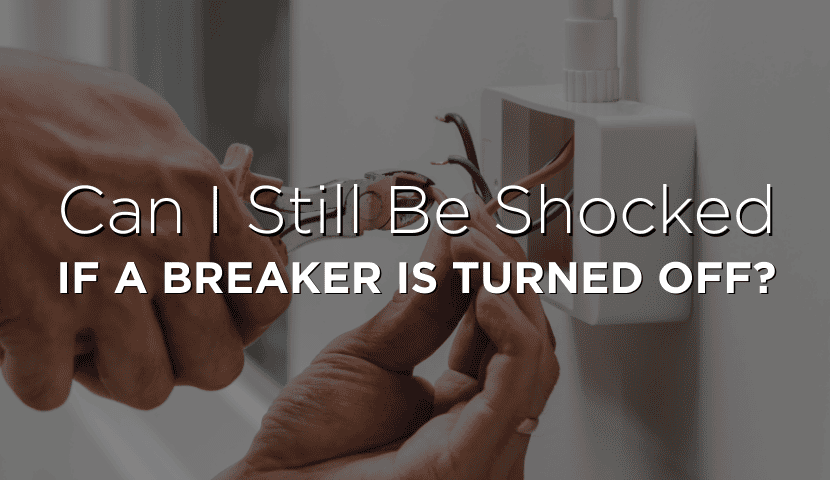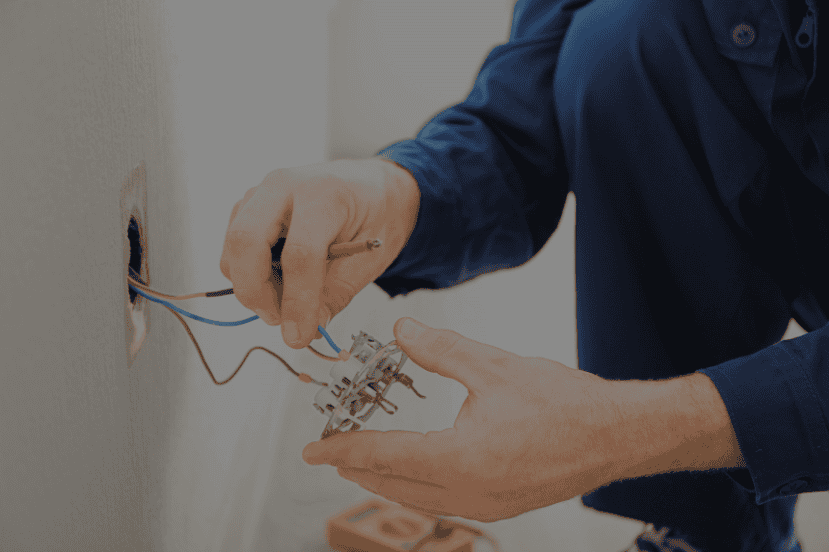
You’re standing in front of your panel, staring at a breaker you just flipped off, and asking yourself: “Am I really safe to work on this outlet now?”
Here’s what you need to know right now:
Critical Safety Information
The short answer is yes, you can still get shocked even with the breaker turned off. But before you panic or continue working, let’s walk through some important safety steps and explain exactly why this happens.
Immediate Safety Steps If You’re Currently Working
Before you touch anything else:
- Test the specific outlet or wire you’re working on – Don’t trust the breaker label alone. Use a non-contact voltage tester on the wires or outlet you plan to work on.
- Test your tester first – Check your voltage tester on a known live outlet to make sure it’s working properly. A dead tester gives you false confidence.
- Turn off multiple breakers if you’re unsure – If you can’t identify the exact circuit, turn off all breakers that might control the area you’re working in.
- Use a contact voltage tester for confirmation – After the non-contact tester shows no voltage, double-check with a contact tester that actually touches the wires.
- If you get any shock at all – Stop immediately, turn off the main breaker if you can safely reach it, and call a professional electrician.
Now that we’ve covered precautions, let’s explain why turning off a breaker doesn’t guarantee your safety and what you’re dealing with.
Why Your Breaker Doesn’t Always Protect You

That neat row of breakers in your panel creates an illusion of simple on/off control. In reality, modern systems are intricate networks where power can flow through paths you’d never imagine.
What we find during emergency calls:
- Circuits that share neutral wires across multiple breakers
- Voltage that jumps between circuits through loose connections
- Ground faults that energize metal components throughout your home
- Back-feeding from solar systems, generators, or neighboring properties
- Multi-wire branch circuits where one “off” breaker leaves others live
The assumption that gets people in trouble: Most homeowners think electricity flows in straight lines from the breaker to the outlet. It doesn’t. Electricity takes every available path to complete its circuit, including paths created by faults, shared neutrals, and deteriorated connections.
The 3 Hidden Dangers That Make Breakers Unreliable
1. The Mislabeling Problem That’s Hiding in 80% of South Florida Homes
Walk through any neighborhood built before 2000, and you’ll find panels that are archaeological records of decades of changes, additions, and “quick fixes.” We estimate that 4 out of 5 homes we service have breaker labels that range from misleading to completely wrong.
Why labels become unreliable:
- Previous owners who did their own work
- Contractors who finished jobs but skipped updating labels
- Room additions that tapped into existing circuits
- Kitchen and bathroom renovations that changed circuit loads
The financial reality: Circuit mapping takes a licensed electrician 2-4 hours and costs $300-500. Many homeowners skip this to save money, but when accidents occur, leading to fires, insurance claims, and remediation work, costs can reach $5,000-15,000.
What professional technicians find during panel audits:
- Single breakers controlling outlets in 4-5 different rooms
- “Mystery circuits” that nobody can trace or identify
- Shared neutrals that create shock risks even with breakers off
Why basic testing equipment has limitations: Homeowner-grade voltage testers can give unreliable readings near fluorescent lights, electronic devices, and in Florida’s humid conditions. Professional technicians invest $500-2,000 in specialized testing equipment because accurate readings are essential for safe work.
2. Loose Connections: The Hidden Problem Behind Your Walls

Every connection in your home experiences thermal cycling, expanding when current flows, contracting when it stops. Over time, this constant movement can loosen connections. Loose connections don’t just affect performance; they create unpredictable current paths that can energize metal components throughout your home.
How loose connections create problems with your breaker’s protection: When neutral wire connections get loose, electricity looks for other ways to get back to your panel. Unfortunately, it often finds these paths through the metal parts of your system – the same metal parts that are supposed to keep you safe. When this happens, touching a light switch, outlet cover, or box can shock you even if you turned off the breaker.
Why older homes have special challenges: If your home was built between 1965 and 1975, it might have aluminum wiring instead of copper. When aluminum wires heat up and cool down (which happens every time you use electricity), they expand and shrink differently than copper connections. Over the years, this creates loose spots that can overheat. The Consumer Product Safety Commission found that homes with this wiring have a higher chance of fires if connections aren’t properly maintained.
Common connection problems we encounter:
- Backstabbed outlets where wires are pushed into holes instead of secured under screws
- Wire nuts that have worked loose from decades of thermal cycling
- Aluminum wiring connections that have oxidized and need attention
- Older panels with components that may not function as intended
- Corroded connections in Florida’s salt air environment
3. Multi-Wire Branch Circuits: Why Code-Compliant Wiring Can Still Surprise You
Today’s codes allow multi-wire branch circuits. Think of it like a highway with two lanes of traffic sharing the same return path. These circuits use two hot wires and one shared neutral wire to power multiple areas efficiently. They’re completely legal and work well when installed properly, but they create situations where turning off one breaker doesn’t shut off all the electricity in that area.
Where you’ll typically find these circuits:
- Kitchen counter outlets (building codes require this for adequate power)
- Bathroom circuits that serve multiple bathrooms
- Bedroom circuits in homes built after 1990
- Garage and workshop areas
A common scenario that catches homeowners off guard: You turn off the breaker labeled “Kitchen East Wall” and start working on an outlet, thinking you’re working safely. But the “Kitchen West Wall” breaker is still on, and both sides share the same neutral wire. If you touch that neutral wire, you can get an unexpected shock because electricity is still flowing through it from the other side of the kitchen.
Why this creates confusion:
- You might get voltage readings on circuits you think are turned off
- Problems on one side can affect the entire shared circuit
- GFCI and AFCI safety devices work differently with shared neutrals
- Figuring out which circuits are connected requires professional testing equipment
🚨 Experiencing Issues Right Now?
Don’t risk your safety with DIY work. Our licensed technicians are available for emergency service throughout South Florida.
Why Professional Help Is Essential
Advanced Testing Equipment That Homeowners Don’t Have
Professional technicians carry diagnostic equipment worth thousands of dollars because accurate readings can mean the difference between a safe repair and a recurring problem. Our thermal cameras can spot loose connections that are invisible to the naked eye, but running 50-100 degrees hotter than they should be. We use special tools that can trace wires through your walls and ceilings to find hidden connections you’d never know were there.
These tools help us figure out exactly why you’re getting shocked even with the breaker turned off. They can identify shared wiring and unexpected connections that create these confusing situations. This thorough approach to diagnosis often reveals problems that basic voltage testers would completely miss.
The Knowledge That Comes from Decades of South Florida Service
Every technician at Elcon Electric has seen situations that don’t match textbook scenarios. We know that homes built in Coral Springs in the 1980s often have aluminum wiring connections that need special attention. We’ve learned that waterfront properties in Palm Beach County experience connection corrosion that develops differently than inland homes.
This local knowledge matters when diagnosing problems. We can often identify the likely cause of an issue by knowing when your home was built and which contractor originally did the work. That experience saves time during diagnosis and helps us recommend solutions that will last in our specific climate.
What Professional Service Actually Costs vs. The Alternative
Most homeowners are surprised to learn that a typical service call for a diagnosis or repair costs less than expected, running between $150-$300. When you compare these costs to potential expenses from problems that can cost $3,000-$8,000, and fire remediation often reaches $15,000-$100,000 – hiring a professional service becomes the clear financial winner.
We’ve seen too many situations where homeowners spend $200 trying to fix something themselves, only to call us when the problem gets worse, resulting in $800 worth of professional repairs to fix the original issue and the complications it created.
Florida’s Climate Makes This Work More Challenging

Humidity and Corrosion Effects
Florida’s constant humidity accelerates corrosion of connections. What might take 20 years to develop problems in Arizona can show issues in 8-10 years in South Florida. Coastal areas experience accelerated corrosion that can turn minor problems into significant concerns within months rather than years.
Lightning and Surge Protection Needs
Florida experiences more lightning strikes per square mile than any other state. Proper grounding and surge protection aren’t luxuries in our climate – they’re necessities for protecting your investment.
⚡ Warning Signs Your System Needs Professional Attention
Call for immediate professional help if you notice:
- Burning smells from components
- Sparks from outlets or switches
- Components that feel warm or hot to the touch
- Frequent circuit breaker trips
- Lights that flicker when appliances turn on
- Any shock, regardless of severity
These symptoms often indicate loose connections, overloaded circuits, or grounding problems that create the “shocked with breaker off” situations we’ve discussed.
The Bottom Line: Your Safety Is Worth More Than DIY Savings
Safety isn’t something you can learn from YouTube videos or online tutorials. The physics of electricity, the complexity of modern systems, and the consequences of mistakes make professional service not just advisable – it’s essential.
The question, “Can I still be shocked if a breaker is turned off?” tells us you’re dealing with complexities beyond simple switch replacement. The safe answer is to follow the suggested steps outlined, then call professionals with the training, equipment, and experience to diagnose and repair problems correctly.
Your family’s safety, your home’s value, and your peace of mind are worth more than the cost of professional service. When considering the potential costs of accidents, professional work is the safe, wise, and economical choice.

